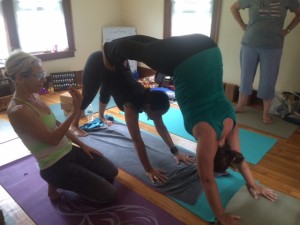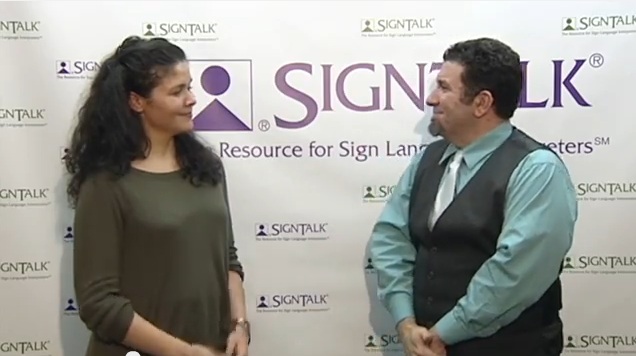
Photo by Jennifer Wilkinson http://www.consciouscontactli.com/about.html
I wholeheartedly encourage everyone in the world to try yoga – I practice regularly up to five or six times a week. It has changed my life — helped me be a better mother, gotten me through rough patches in my life, brought me better health, more energy, and a sense of inner well- being.
A few months ago, I suggested to a deaf friend that she come to yoga with me. She immediately responded, “Well, I would love to… but I can’t. I’m deaf. How will I follow the class?” I said, “What do you mean, you CAN’T? Of course you CAN. Just show up to class. I’ll be there by your side, and I guarantee you will feel comfortable.”
Thankfully, she agreed.
I arrived 20 minutes early to prepare my teacher at the yoga studio in Greenpoint, Brooklyn for the deaf yogi that would be attending her class. I’m an ASL interpreter and I taught her a few basic signs — breathe, inhale, exhale, child’s pose, relax — and told her to teach the class just as she always does. I arranged my friend’s mat and props in the center row so that she would have a clear sightline of all angles and students.
I arranged my mat next to hers — I didn’t plan on interpreting in front of the class, but rather alongside her.
When my friend arrived she seemed nervous yet excited. Throughout the practice I used touch signals to let her know when to open and close her eyes or to change movement. When we were lying on our backs for back bends or seated pigeon, I would hold her hand and squeeze it to communicate any new information. When we were both in downward dog (Adho Mukha Svanasana) pose, I lifted my right hand slightly and finger spelled LEG then moved my right arm up and bent it at the elbow. She knew to lift her right leg and bend it while following others in the class. I did the same with the left arm when it came time to do the other side.
All the while, I was reminding her to breathe so she understood the importance of Ujjayi breath (a technique used in most yoga practices). I was continuously signing inhale or exhale whenever I had a free hand. Breathing is definitely the most important part of yoga. This Ujjayi breath is a friction breath creating an audible sound on the throat which is often heard by the students. At one point I took my friends’ hand to my throat so she could feel the friction on my throat of the exhale. and then had her watch my nose and belly as I took a deep inhale. I described fogging up a mirror with the exhale. This amazing sound gives not only a focus to the practice but also creates heat in the body as well.
The class (although not as focused for me as my regular practice) was an incredible experience. My friend signed up for a class card. Success!
After that experience, I attended an ASL weekend yoga/meditation retreat in Delaware County. I was one of two hearing individuals. The entire weekend was conducted in ASL. It was a life changing experience for me. We practiced yoga, reiki, meditation, and ate family meals together, sharing stories. I came back from this retreat hopeful that more yoga studios would accommodate deaf and hard of hearing students. Where are all the classes for deaf people, I wondered?
Doing my part, I invited another deaf friend to join me for yoga at my studio. This time I interpreted in front of the class. I knew that once I interpreted for my friend a few times she would be able to follow a class on her own.
The teacher and students were all excited to have an interpreter up front. To interpret this class successfully and smoothly, I wore yoga clothes. I demonstrated poses for her once in a while and needed to be prepared.
Many of the asanas (poses) call for eyes closed or head down, so I had to get creative. I signed inhale and exhale on my friends’ back often. When she was in downward dog, I took my fist resembling the head of a person and shook it lightly from side to side directly in her sightline.
She immediately shook her head from side to side. When the teacher instructed the class to hollow out the belly and pull it up towards the spine, I took my left hand and signed a scooping motion of the belly while simultaneously pinching up at her back, pulling it up like a parachute so that she could actually feel it. She totally understood to pull her belly button into her spine.
When it was time to slowly stand up, vertebrae by vertebrae, I signed SLOWLY on her arm then walked my two fingers upwards from her wrist to her elbow.
Child’s pose (balasana) is a simple pose but one in which the head is down and the eyes remain closed. During this pose I signed on both her arms and back. When it was time to lift up her head I drummed my fingers lightly on her mat by her head. She lifted her head.
When she was in shoulder stand (sarvangasana), I stood directly in front of her legs and signed above her. I always made sure to have clear sight lines and bent MY body so as not to interrupt the flow of HER body.
In shavasana (corpse pose) I held firmly onto her ankle. and signed EYES CLOSE. She kept her eyes closed and was able to relax, not wondering when to open them because she felt the firmness of my grasp. The teacher went around massaging oil into our chests, necks and temples. I saw my friend smile in full relaxation mode while inhaling the scent of lavender. When the teacher instructed, after five minutes or so, to bring back the breath, wiggle fingers and toes and wake up the body, I lightly let go of her ankle and she opened her eyes. An unspoken trust.
Practicing side by side OR interpreting with/for a deaf friend requires mindfulness, compassion and a knowledge of yoga. The physical and spiritual experience can be incredibly rewarding for both. It is so empowering for a Deaf person to walk into any class at any time and say, I CAN and I will. All it takes is a human body and soul. And of course, breath.
Resources for Deaf yoga:
www.deafhoodyoga.com
www.deafyoga.org
www.consciouscontactli.com/about.html
www.deafrootsandwings.com
www.yogajournal.com/category/poses









